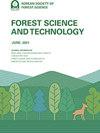Litterfall release, vegetative, and reproductive phenology investigation of Heritiera fomes Buch-Ham in the Sundarbans mangrove forests, Bangladesh: relationship with environmental variables
IF 2.2
Q2 FORESTRY
引用次数: 7
Abstract
Abstract The study of vegetative and reproductive phenology through litterfall collection of mangrove species is vital for mangrove management and restoration in climate change situation. This study was carried out to investigate vegetative and reproductive phenological pattern of Heritiera fomes using litterfall data in the Sundarbans, Bangladesh for a period of 24 months. Leaf and stipule litterfall released throughout the year with a distinct periodic pattern. Vegetative litterfall (981.9–1211.3 g/sq m/yr) contributed 59.3% of total litterfall (1791.1–1907.3 g/m/yr). The order of vegetative litterfall was leaf > branch > stipule. Peak flowering and mature fruit litterfall were noticed in April (1.52 times of mean monthly flower production) and July (1.56 times of mean monthly production), respectively. Analysis of variance (ANOVA) showed significant difference (p < 0.05) among monthly litterfall productions, whereas t-test showed no significant difference (p > 0.05) of litterfall production between two successive years during study periods. Vegetative and flower litterfall were significantly influenced by maximum wind speed, mean monthly temperature and day length. On the contrary, mature fruits were significantly correlated with rainfall.孟加拉国孙德尔本斯红树林的凋落物释放、营养和生殖物候研究:与环境变量的关系
摘要利用红树林凋落物研究红树林的营养和生殖物候特征,对气候变化条件下红树林的管理和恢复具有重要意义。本研究利用孟加拉国孙德尔本斯地区24个月的凋落物资料,调查了遗传属植物的营养和生殖物候模式。叶和托叶凋落物在一年中以明显的周期性模式释放。植被凋落物(981.9 ~ 1211.3 g/m/yr)占总凋落物(1791.1 ~ 1907.3 g/m/yr)的59.3%。营养凋落物的大小顺序为叶>枝>托叶。开花高峰出现在4月(月均产花量的1.52倍),成熟果实凋落量出现在7月(月均产花量的1.56倍)。方差分析(ANOVA)显示,研究期间连续两年的凋落物产量差异显著(p 0.05)。最大风速、月平均气温和日长对植物凋落物和花凋落物有显著影响。相反,成熟果实与降雨量呈极显著相关。
本文章由计算机程序翻译,如有差异,请以英文原文为准。
求助全文
约1分钟内获得全文
求助全文

 求助内容:
求助内容: 应助结果提醒方式:
应助结果提醒方式:


